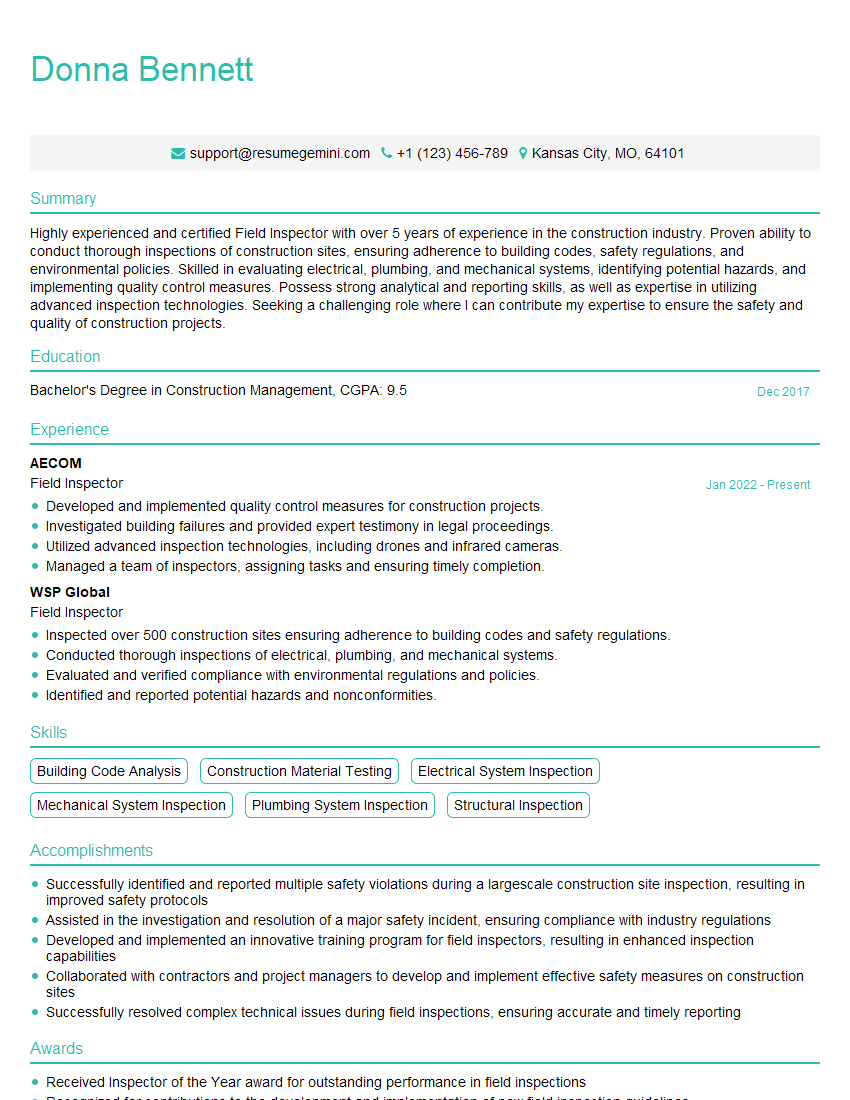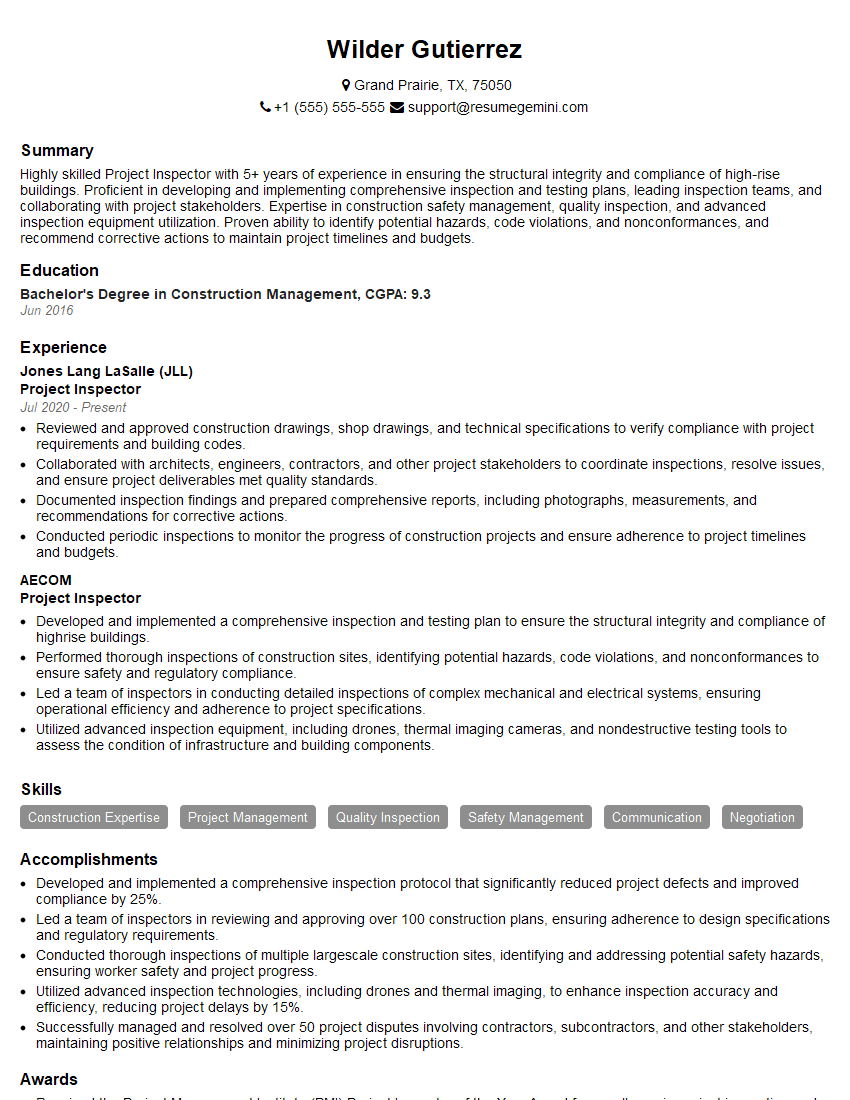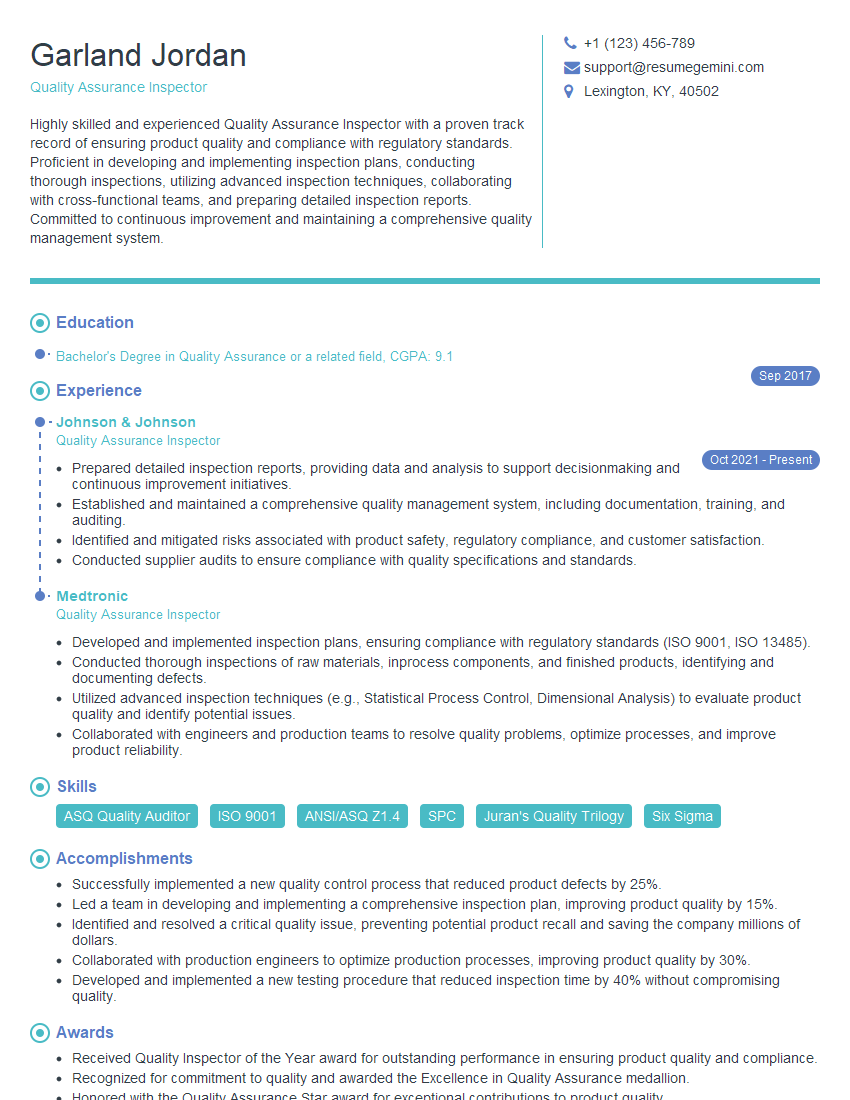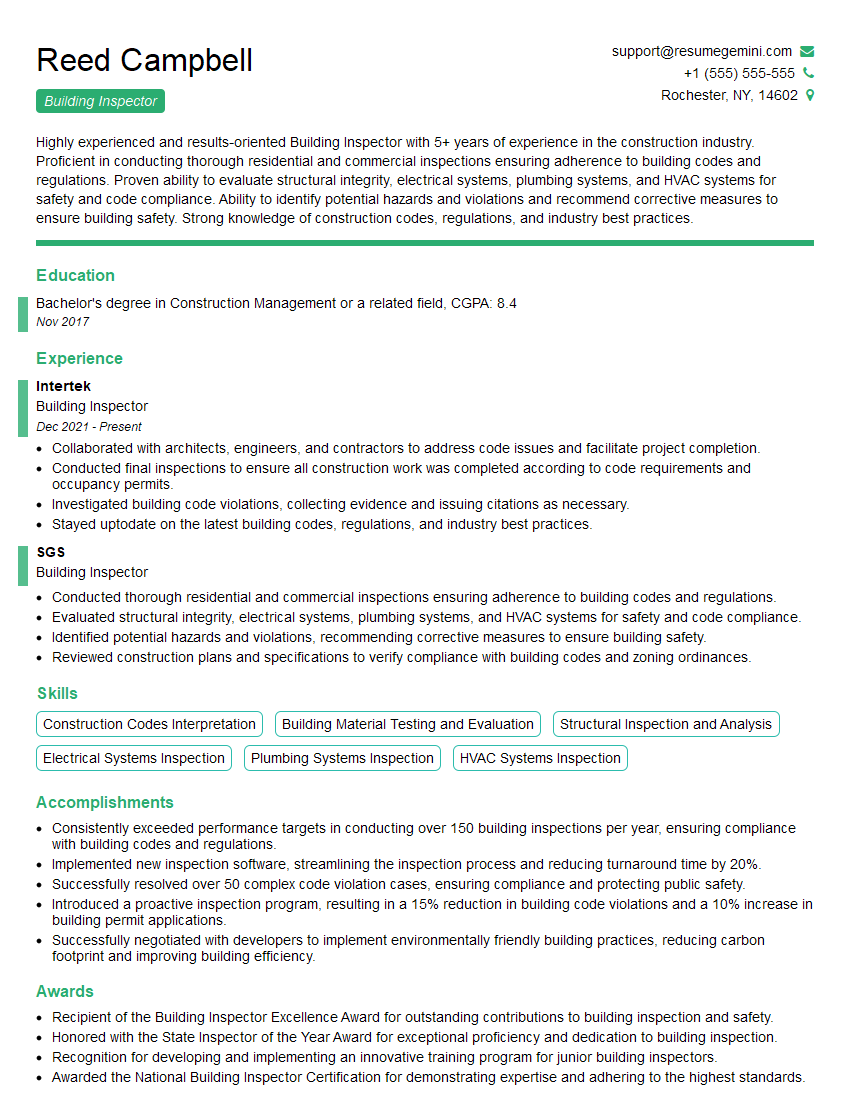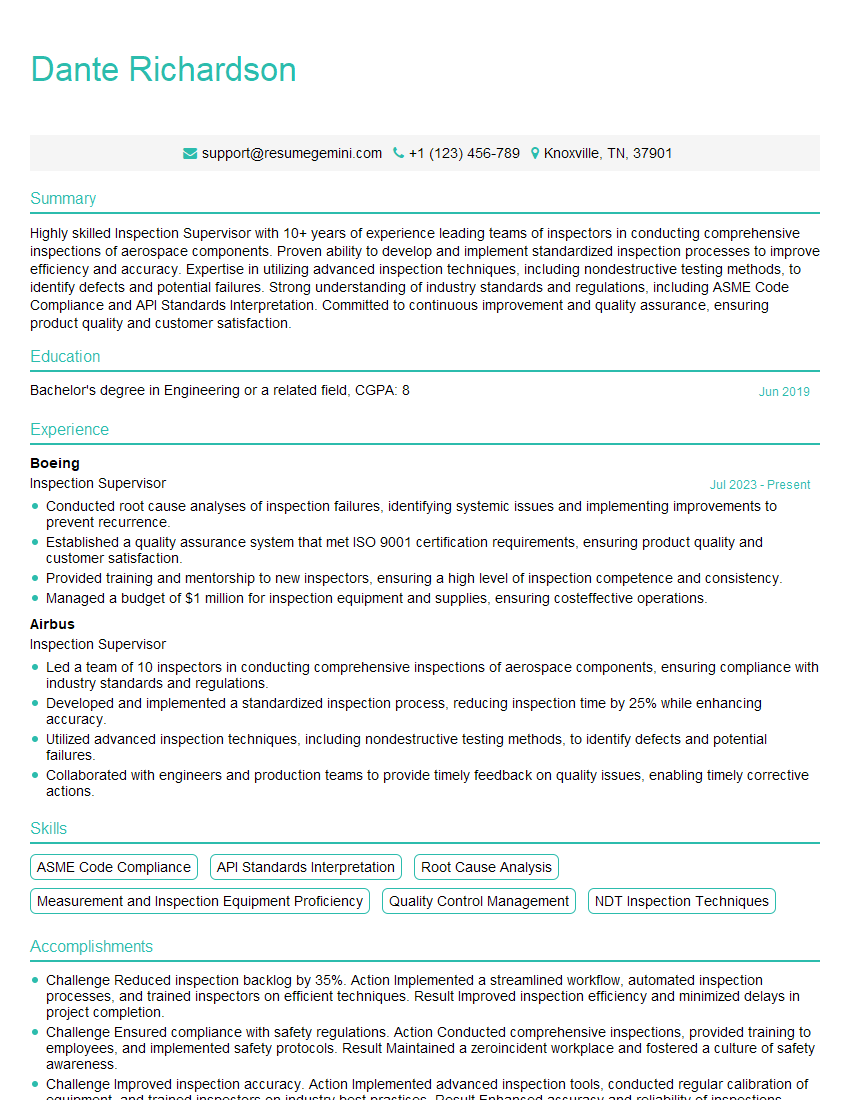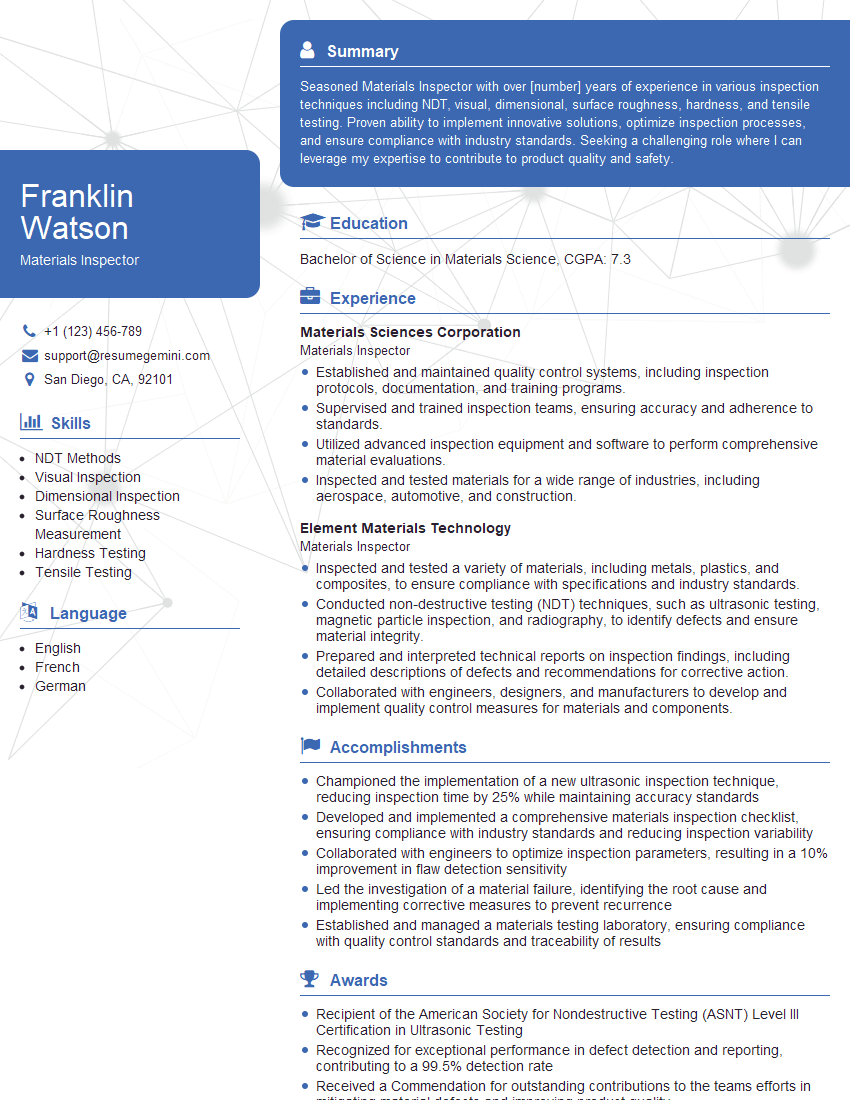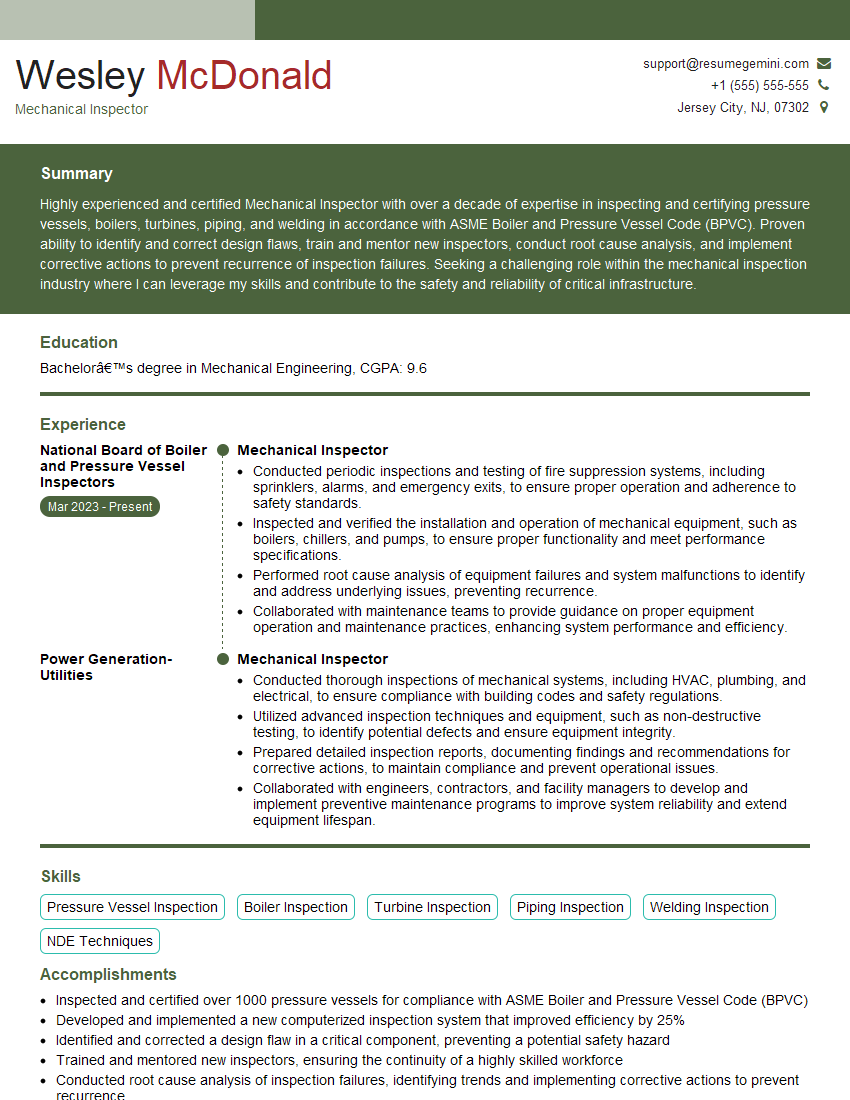Interviews are more than just a Q&A session—they’re a chance to prove your worth. This blog dives into essential Project Inspection interview questions and expert tips to help you align your answers with what hiring managers are looking for. Start preparing to shine!
Questions Asked in Project Inspection Interview
Q 1. Explain your experience with different types of inspection reports.
Throughout my career, I’ve compiled and reviewed various inspection reports, each tailored to the specific project and its requirements. These range from simple checklists for minor renovations to extensive, multi-section reports for large-scale construction projects.
- Initial Inspection Reports: These document the project’s initial condition, highlighting existing issues and setting a baseline for future comparisons. For example, a pre-construction inspection might note the condition of existing utilities or the presence of asbestos.
- Progress Reports: These track the progress of the project at various stages, documenting completed work and any deviations from the plans. A mid-construction inspection report might identify discrepancies between the approved plans and the actual work performed.
- Final Inspection Reports: These are comprehensive documents that summarize the entire inspection process, highlighting all completed work, identified non-conformances and their resolutions, and ultimately determining the project’s compliance with relevant codes and regulations. A final inspection report might include photos, measurements, and test results.
- Specialized Reports: Depending on the project, specialized reports might focus on specific aspects, such as structural integrity, fire safety, or electrical systems. These may involve detailed calculations or test data analysis.
My experience allows me to adapt my reporting style to meet the specific needs of each project and stakeholder. I am adept at using clear, concise language, and I always ensure that my reports are well-organized and easy to understand, even for individuals without technical expertise.
Q 2. Describe your process for identifying and documenting non-conformances.
Identifying and documenting non-conformances is a crucial part of my inspection process. I use a methodical approach that ensures thoroughness and accuracy.
- Visual Inspection: I begin with a thorough visual inspection, comparing the work against the approved plans and specifications. This often includes taking photographs and detailed measurements to document findings.
- Testing and Verification: When appropriate, I utilize various testing methods (e.g., material testing, load testing) to verify the work’s quality and compliance with standards.
- Documentation: I meticulously document all non-conformances, using a standardized format that includes the location of the non-conformance, a description of the problem, and photographic evidence. My documentation also includes the severity level of the non-conformance (e.g., minor, major, critical).
- Reporting: I clearly report all findings in the inspection report, using objective language and providing specific details to ensure clarity. This ensures that the contractor understands the necessary corrective actions.
For example, if a wall is not plumb, I would document its deviation from the vertical using precise measurements, include a photograph showcasing the non-conformity, and classify it according to its severity, considering its impact on structural integrity or other aspects of the project. This systematic approach minimizes ambiguity and promotes effective communication among all project stakeholders.
Q 3. How do you prioritize inspection tasks on a complex project?
Prioritizing inspection tasks on a complex project requires a strategic approach to ensure that the most critical aspects are addressed first and that resources are used efficiently. I typically utilize a risk-based prioritization methodology.
- Risk Assessment: I identify potential risks associated with various aspects of the project, considering factors such as safety, structural integrity, compliance with regulations, and project timelines.
- Criticality Ranking: Each task is then ranked according to its potential impact on the overall project success, taking into account the severity and likelihood of a failure.
- Sequencing: Based on the criticality ranking, I sequence the inspection tasks, prioritizing those with the highest potential impact. For example, structural inspections might be prioritized over aesthetic finishes.
- Resource Allocation: I allocate resources (time, personnel) effectively, ensuring that sufficient resources are dedicated to the higher-priority tasks while still addressing lower-priority tasks in a timely manner.
This approach allows me to focus on the critical path of the project, ensuring that any potential problems are addressed before they escalate and impact other parts of the project. This approach is also flexible and can be adapted depending on the ongoing progress and any emerging risks.
Q 4. What software or tools do you use for project inspection and reporting?
To enhance efficiency and accuracy, I utilize various software and tools for project inspection and reporting. My proficiency spans several platforms and applications, ensuring adaptability to diverse project needs.
- PlanGrid or similar: For accessing and reviewing project drawings, specifications, and RFIs directly on my mobile device during inspections.
- BIM 360 or similar: To collaborate with the project team, share inspection findings, and manage issues throughout the project lifecycle.
- Microsoft Office Suite (Word, Excel, PowerPoint): For creating detailed inspection reports, compiling data, and presenting findings to stakeholders.
- Specialized Testing Equipment: Depending on the project’s requirements, I use specialized tools like moisture meters, thermal cameras, and ultrasonic testing equipment to conduct thorough inspections.
- Mobile Apps for Data Collection: Several apps streamline data entry and photo documentation during inspections, reducing the time spent on manual data entry and ensuring data accuracy.
My familiarity with these tools enables me to create comprehensive and easily accessible reports, which help in effective communication and timely resolution of any issues.
Q 5. Explain your experience with different building codes and regulations.
My experience encompasses a wide range of building codes and regulations, both nationally and internationally. I am familiar with the International Building Code (IBC), the National Electrical Code (NEC), and other relevant codes depending on the project’s location and the specifics of the building.
I’m adept at interpreting these complex documents and applying them to practical situations during inspections. This includes understanding the specific requirements for various building types (residential, commercial, industrial), occupancy classifications, and construction methods. For instance, I understand the differences in fire-resistance requirements for different occupancy types and the implications of those requirements on the construction methods used. My familiarity extends to understanding accessibility requirements (ADA) and energy efficiency standards (e.g., LEED).
Staying current with code changes and updates is paramount. I regularly review code updates and participate in professional development courses to maintain my expertise in this evolving field. This ensures that my inspections are always performed in accordance with the most up-to-date requirements, minimizing risks and ensuring compliance.
Q 6. How do you handle disagreements with contractors regarding inspection findings?
Disagreements with contractors regarding inspection findings are sometimes unavoidable. However, I approach these situations with a focus on collaboration and problem-solving.
- Open Communication: I begin by clearly explaining the basis of my findings, providing supporting evidence such as photographs, measurements, and test results. My communication style emphasizes professionalism and collaboration rather than confrontation.
- Joint Site Visit: I am always willing to revisit the site with the contractor to discuss the findings in more detail and ensure a shared understanding of the issues. This often helps to resolve misunderstandings and clarify any ambiguities.
- Documentation and Formal Process: If a resolution cannot be reached through discussion, I follow established project procedures to document the disagreement formally. This may include submitting a written report, outlining the non-conformance, the contractor’s response, and a proposed resolution.
- Escalation (if necessary): In cases where the disagreement cannot be resolved at the project level, I will follow the established escalation procedures to involve higher-level management from both sides. This ensures a fair and impartial review of the matter.
My goal is always to reach a mutually agreeable solution that ensures the project complies with all relevant codes and regulations while maintaining a positive working relationship with the contractor.
Q 7. Describe your experience with various inspection methods (visual, testing, etc.).
My experience encompasses a wide array of inspection methods, ranging from simple visual observations to sophisticated testing procedures. I adapt my approach based on the specific requirements of the project and the aspects being inspected.
- Visual Inspection: This is the foundation of most inspections, involving a careful examination of the work to identify any visible defects or non-conformances. This might include checking for proper alignment, levelness, finish quality, and the absence of damage.
- Dimensional Checks: Using measuring tools (tapes, levels, etc.) to verify that construction elements meet the specified dimensions and tolerances.
- Material Testing: This involves testing materials to ensure that they meet the specified requirements for strength, durability, and other properties. This might include concrete testing, soil testing, or testing of specific components.
- Non-Destructive Testing (NDT): Techniques such as ultrasonic testing or radiographic testing can be used to detect hidden defects or flaws without damaging the material.
- In-situ Testing: Testing materials or systems in their installed position, such as checking the strength of concrete after it has been poured.
- Performance Testing: Testing systems to ensure that they function as intended, such as testing the performance of HVAC systems or plumbing systems.
The combination of these various inspection methods ensures a thorough and comprehensive assessment of the project’s quality and compliance.
Q 8. How do you ensure the accuracy and completeness of your inspection reports?
Ensuring accuracy and completeness in inspection reports is paramount. It’s like being a detective, meticulously gathering evidence to support your conclusions. My approach is multifaceted and relies on a combination of careful observation, thorough documentation, and a systematic review process.
Detailed Checklists: I utilize pre-prepared checklists tailored to the specific project phase and scope. This ensures consistent coverage of all critical aspects, minimizing the chance of overlooking details. For example, during a concrete pour inspection, my checklist would include checks for slump test results, reinforcement placement, curing methods, and finishing standards.
Digital Documentation: I rely heavily on digital tools. High-resolution photos and videos, along with detailed written observations, are crucial. I use timestamped photographs to record progress and any discrepancies. This creates a comprehensive and irrefutable record.
Independent Verification: Whenever feasible, I conduct a second, independent review of my findings. This is akin to having a colleague proofread a critical report; it helps identify any potential oversights or biases in my initial assessment.
Clear and Concise Reporting: My reports are structured, clear, and use precise language, avoiding ambiguity. I prioritize objective descriptions and avoid subjective opinions unless backed by concrete evidence. This clarity is essential for quick understanding and informed decision-making by project stakeholders.
Q 9. What is your experience with safety procedures during project inspections?
Safety is my top priority. Every inspection is conducted with a strong focus on adhering to stringent safety protocols. Think of it like this: safety isn’t just a checklist item; it’s the foundation upon which the entire inspection process is built. My experience includes:
PPE (Personal Protective Equipment): I always wear appropriate PPE, including hard hats, safety glasses, high-visibility vests, and steel-toed boots, regardless of the project’s apparent risk level.
Site-Specific Safety Plans: I thoroughly review and comply with the site-specific safety plans developed by the contractor. This includes understanding and respecting designated walkways, restricted areas, and emergency procedures.
Hazard Identification and Reporting: I’m trained to identify potential hazards, such as exposed wiring, unsafe scaffolding, or improper material handling. Any unsafe conditions are immediately reported to the site supervisor for immediate corrective action.
Emergency Response Training: I’ve completed training in emergency response procedures, including first aid and CPR, enabling me to react effectively in unforeseen circumstances. This preparedness is critical, ensuring I can both protect myself and offer immediate assistance if needed.
Q 10. How do you manage your time effectively during a busy inspection schedule?
Managing time effectively during a busy inspection schedule requires a strategic and organized approach. It’s like orchestrating a symphony – each instrument (task) needs to be played at the right time to create a harmonious whole (efficient schedule). My strategies include:
Prioritization: I prioritize inspections based on criticality and deadlines. Urgent inspections, such as those related to safety concerns, take precedence.
Efficient Routing: I plan my routes to minimize travel time between project sites. This involves using mapping software and considering traffic patterns.
Time Blocking: I allocate specific time blocks for each inspection, factoring in travel time, the inspection itself, and report writing. I also build in buffer time to accommodate unexpected delays.
Technology Utilization: I utilize mobile apps and software for scheduling, reporting, and communication, streamlining the process and reducing administrative overhead.
Q 11. Describe your experience with different types of construction materials.
My experience with construction materials is extensive, encompassing a wide range of materials used in various construction projects. I’m familiar with their properties, applications, and potential defects. My knowledge spans from traditional materials to modern composites.
Concrete: I’m proficient in evaluating concrete mixes, assessing its strength and durability, and identifying defects like cracking, honeycombing, and segregation. I understand the importance of proper curing and finishing techniques.
Steel: I can identify different steel grades and assess their quality, including checking for corrosion, welding defects, and proper connections. My expertise includes evaluating structural steel members and reinforcement bars.
Wood: I can distinguish different types of lumber, assess their quality, and identify defects like knots, decay, and warping. I’m familiar with different wood treatments and their impact on durability.
Masonry: I’m well-versed in evaluating different types of masonry units, including bricks, blocks, and stones. I assess their bond, mortar quality, and overall structural integrity.
Modern Materials: I’m also familiar with newer materials like composite materials, high-performance concrete, and sustainable building materials, understanding their unique characteristics and applications.
Q 12. How familiar are you with contract documents and their relevance to inspection?
Contract documents are the bedrock of any project. They’re the legal agreement that outlines the scope of work, specifications, and standards. A thorough understanding of these documents is essential for conducting effective inspections. It’s like having a blueprint for the detective work – you need it to ensure you’re looking in the right places for the right things.
Specifications: I meticulously review the project specifications to understand the required materials, workmanship standards, and quality control measures. This ensures I can assess whether the work complies with the contract requirements.
Drawings: I refer to the project drawings to verify the actual construction against the design. This includes checking dimensions, locations, and connections of various elements.
Schedules: Understanding the project schedule helps me determine the expected progress and assess whether the work is on track.
Amendments and Addenda: I’m aware of the importance of any amendments or addenda to the contract documents; these can alter specifications, scope of work, or deadlines. I ensure my inspections reflect the most up-to-date information.
Q 13. How do you identify potential risks and hazards during inspections?
Identifying potential risks and hazards during inspections is a crucial aspect of my role. It’s like being a proactive safety officer, anticipating problems before they happen. My approach combines systematic observation with an understanding of construction best practices.
Systematic Walkthroughs: I conduct methodical walkthroughs of the project site, systematically checking for potential hazards. I pay particular attention to areas with ongoing work, heavy machinery, and stored materials.
Hazard Recognition Training: My training has equipped me to identify a range of potential hazards, including fall hazards, electrical hazards, fire hazards, and chemical hazards.
Checklists and Protocols: I utilize checklists tailored to different construction phases, ensuring consistent hazard identification and reporting.
Communication and Reporting: Any identified hazards are immediately reported to the site supervisor using established communication channels. I follow up to ensure corrective action is taken.
Q 14. How do you communicate effectively with project stakeholders regarding inspection results?
Effective communication with project stakeholders is critical for successful project outcomes. It’s about ensuring everyone is on the same page, sharing information transparently and professionally. My communication strategies encompass a variety of methods:
Clear and Concise Reports: My inspection reports are written clearly, concisely, and objectively, avoiding technical jargon whenever possible.
Regular Updates: I provide regular updates to project managers and other stakeholders, keeping them informed of project progress and any identified issues.
Visual Aids: I utilize photographs and videos to illustrate my findings, making it easier for stakeholders to understand the issues.
Formal Meetings: I participate in project meetings, presenting my findings and discussing potential solutions with the project team.
Constructive Feedback: I focus on providing constructive feedback, offering suggestions for improvement and focusing on solutions rather than simply highlighting problems.
Q 15. Describe your experience with using inspection checklists and forms.
Inspection checklists and forms are crucial for ensuring consistency and thoroughness in project inspections. They act as a structured guide, preventing oversight and ensuring all critical aspects are checked. My experience involves developing, customizing, and utilizing these tools across various projects, from small-scale renovations to large-scale construction endeavors.
For example, on a recent high-rise construction project, I used a customized checklist covering structural integrity, fire safety systems, electrical compliance, and HVAC functionality. Each checklist item included space for observations, photographic evidence (often linked digitally), and a severity rating for any identified non-conformances. This allowed for efficient tracking and prioritization of corrective actions. Another example involved adapting a generic checklist for a historical building renovation, incorporating specific considerations for preservation guidelines and material compatibility. This adaptability is key to successful checklist implementation.
- Development: I actively participate in designing checklists, tailoring them to project specifics and relevant codes.
- Customization: I adapt existing checklists based on project needs, incorporating specific requirements and risk factors.
- Implementation: I train inspectors on proper use of checklists and forms, ensuring accurate and consistent data collection.
- Review and Improvement: I regularly review checklist effectiveness and incorporate lessons learned to improve accuracy and efficiency.
Career Expert Tips:
- Ace those interviews! Prepare effectively by reviewing the Top 50 Most Common Interview Questions on ResumeGemini.
- Navigate your job search with confidence! Explore a wide range of Career Tips on ResumeGemini. Learn about common challenges and recommendations to overcome them.
- Craft the perfect resume! Master the Art of Resume Writing with ResumeGemini’s guide. Showcase your unique qualifications and achievements effectively.
- Don’t miss out on holiday savings! Build your dream resume with ResumeGemini’s ATS optimized templates.
Q 16. What are your strategies for resolving conflicts between design specifications and actual construction?
Conflicts between design specifications and actual construction are unfortunately common. My strategy for resolving them involves a systematic approach focusing on documentation, communication, and collaborative problem-solving.
- Documentation Review: I meticulously review the original design documents, including drawings, specifications, and change orders, to pinpoint the discrepancy’s root cause.
- On-site Verification: I conduct a thorough on-site inspection to visually verify the conflict and gather evidence through photographs and measurements.
- Stakeholder Communication: I convene a meeting with the architect, contractor, and relevant engineers to discuss the discrepancy, present my findings, and facilitate a joint understanding of the problem.
- Resolution Options: We collaboratively explore solutions, including design modifications, material substitutions (with approvals), or adjustments to the construction schedule. The best solution is always chosen based on safety, cost-effectiveness, and adherence to project goals.
- Documentation of Resolution: The agreed-upon resolution is formally documented through a change order or other official record, ensuring transparency and accountability.
For instance, I once encountered a situation where the specified steel beams were incorrectly installed. Through careful documentation and collaborative discussion, we determined that a minor adjustment in the supporting structure could resolve the issue without significant delays or cost overruns. The revised plan was documented, approved, and implemented successfully.
Q 17. How do you handle situations where inspections reveal significant deficiencies?
Significant deficiencies discovered during inspections require immediate and decisive action. My approach focuses on a multi-stage process prioritizing safety and regulatory compliance.
- Immediate Notification: I immediately notify the project manager and relevant stakeholders about the deficiency, clearly explaining the severity and potential implications.
- Detailed Documentation: I thoroughly document the deficiency, including photographs, measurements, and a detailed description of the problem. This documentation serves as evidence for corrective actions and potential legal ramifications.
- Risk Assessment: I conduct a risk assessment to determine the potential impact of the deficiency on safety, functionality, and project timeline. This assessment guides the prioritization of corrective measures.
- Corrective Action Plan: I work collaboratively with the contractor to develop a detailed corrective action plan, specifying the necessary repairs or replacements, timelines, and responsible parties. This plan is subject to review and approval by relevant stakeholders.
- Monitoring and Verification: Once the corrective actions are completed, I conduct a follow-up inspection to verify the adequacy of the repairs and ensure compliance with standards and specifications.
- Documentation of Resolution: The entire process, including the identified deficiency, corrective actions, and verification, is meticulously documented.
In one instance, I discovered significant fireproofing deficiencies in a high-rise building. Following the above steps, we immediately halted work on relevant floors and implemented an emergency corrective plan. This avoided a potential catastrophic event and ensured the building met safety codes.
Q 18. Describe your experience with using inspection equipment (e.g., measuring tools, testing devices).
Proficient use of inspection equipment is fundamental to accurate and effective inspections. My experience encompasses a wide range of tools, from basic measuring devices to sophisticated testing equipment.
- Measuring Tools: I regularly utilize tape measures, laser distance meters, levels, and calipers for accurate dimensional checks and verification of alignments.
- Testing Devices: I am experienced with using moisture meters, concrete testers, and various electrical testing equipment to assess material quality and system functionality.
- Specialized Equipment: Depending on the project, I may utilize more specialized equipment, such as thermal imaging cameras for detecting insulation deficiencies or ultrasonic testing devices for evaluating structural integrity.
- Calibration and Maintenance: I understand the importance of equipment calibration and regular maintenance to ensure accuracy and reliability. All equipment used is regularly checked and calibrated to standards.
For example, on a recent project involving concrete structures, I used a rebound hammer to assess the concrete’s compressive strength, ensuring compliance with design specifications. The results were documented and used to guide decision-making regarding potential remedial work.
Q 19. What is your experience with reviewing submittals and shop drawings?
Reviewing submittals and shop drawings is a critical aspect of quality control. This process allows for early identification of potential issues before they manifest in the field, saving time and resources.
My experience involves a thorough review process which includes:
- Compliance Verification: I verify that the submittals and shop drawings comply with the project specifications, relevant codes, and industry standards.
- Coordination Checks: I check for coordination between different disciplines (e.g., structural, mechanical, electrical) to identify any potential clashes or conflicts.
- Detailing Review: I examine details such as dimensions, materials, and construction methods to ensure accuracy and feasibility.
- Code Compliance: I assess compliance with all applicable building codes and regulations.
- Clear Communication: I provide clear and concise feedback to the contractor regarding any discrepancies or required revisions.
For instance, I once identified a crucial omission in a shop drawing for a steel connection detail. Catching this early prevented a costly error during construction, highlighting the importance of careful submittal review.
Q 20. How do you ensure inspections are conducted in a timely and efficient manner?
Timely and efficient inspections are essential for maintaining project momentum and minimizing disruptions. My strategies for ensuring this include:
- Planning and Scheduling: I collaborate with the project team to develop a detailed inspection schedule that aligns with the construction progress and milestones. This schedule considers accessibility, availability of personnel, and the complexity of different phases.
- Prioritization: I prioritize inspections based on risk assessment and criticality. High-risk activities receive more frequent and thorough inspections.
- Efficient Inspection Techniques: I employ efficient inspection techniques such as using checklists, digital documentation (photos, videos), and effective communication to streamline the process.
- Regular Reporting: I provide regular reports to the project team, highlighting inspection findings, any identified deficiencies, and the status of corrective actions. This ensures transparency and promotes accountability.
- Technology Integration: I leverage technology, such as mobile inspection apps and cloud-based documentation platforms, to improve efficiency and accessibility of inspection data.
For example, I utilize a mobile app that allows for real-time documentation of findings, including photographs and location data, which streamlines report generation and sharing.
Q 21. Describe a time you had to make a difficult decision during an inspection.
During a large-scale infrastructure project, I encountered a situation where a critical component showed signs of significant wear during an inspection, but the contractor argued that it was still within acceptable limits. Replacing the component would cause significant delays and cost overruns.
The decision was difficult because it involved balancing cost and time constraints with safety and regulatory compliance. After careful deliberation involving thorough documentation, independent verification, and consultation with engineering specialists, I decided to recommend replacement. While this decision resulted in temporary delays, it prevented a potentially catastrophic failure in the long run. The rationale for my decision – prioritizing safety above all else – was thoroughly documented and accepted by the project stakeholders. This situation underscored the importance of impartial judgment and adherence to safety regulations, even when facing considerable pressure.
Q 22. How do you maintain your professional development in the field of project inspection?
Maintaining professional development in project inspection is crucial for staying abreast of industry best practices, new technologies, and evolving regulations. My approach is multifaceted:
- Continuous Learning: I actively participate in relevant professional development courses and workshops offered by organizations like the American Society for Testing and Materials (ASTM) and the Institute of Inspection, Testing and Certification (IITC). This ensures I’m updated on the latest inspection techniques, standards, and software.
- Industry Publications and Conferences: I regularly read industry journals and attend conferences to learn about emerging trends, case studies, and innovative solutions in project inspection. Networking with peers at these events provides valuable insights and allows for the exchange of best practices.
- Mentorship and Peer Learning: I actively seek mentorship from experienced inspectors and engage in peer-to-peer learning to share knowledge and learn from others’ experiences. This collaborative approach helps identify potential blind spots and refine my inspection methodologies.
- Self-Study and Research: I dedicate time to independent research and study, focusing on specific areas needing improvement or new technologies relevant to my work. This includes exploring new software for data analysis and documentation.
This comprehensive approach allows me to continuously enhance my skills and ensure I consistently deliver high-quality inspection services.
Q 23. Explain your understanding of quality control processes in construction.
Quality control (QC) in construction is a systematic process designed to ensure that the project meets the predefined quality standards and specifications. It involves a series of planned and systematic actions to provide adequate confidence that a structure or system will perform satisfactorily in service. My understanding encompasses several key aspects:
- Defining Quality Standards: This begins with clearly defined project specifications, blueprints, and relevant codes (e.g., building codes, industry standards). These serve as the benchmark against which the work is measured.
- Inspection Planning: A detailed inspection plan is crucial. It outlines the frequency, scope, and methods of inspection, specifying which aspects of the project require attention at different stages. This might involve checklists, templates, or specialized inspection procedures.
- In-Process Inspections: Regular inspections throughout the construction process are vital to identify and address defects early. This is far more cost-effective than rectifying issues later. Timely feedback to contractors helps ensure compliance.
- Testing and Sampling: This involves conducting various tests on materials and components to verify their properties and conformance to standards. For example, concrete strength testing, soil compaction testing, or material composition analysis.
- Documentation: Meticulous record-keeping is essential. This includes detailed inspection reports, photographs, and any supporting evidence (test results, etc.). This documentation serves as a historical record and facilitates problem resolution.
- Corrective Actions: When defects are identified, a formal process for corrective action is necessary. This involves documenting the defect, issuing non-conformance reports, and working with the contractor to implement appropriate remedial measures. Verification of the correction is also vital.
Effective QC processes significantly reduce rework, improve project quality, and mitigate potential risks.
Q 24. How do you incorporate technology to improve efficiency in project inspection?
Technology plays a vital role in enhancing efficiency and accuracy in project inspection. I leverage several technologies to streamline my workflow:
- Drone Technology: Drones equipped with high-resolution cameras provide comprehensive visual inspection of large or difficult-to-access areas, offering a bird’s-eye view and detailed imagery. This significantly speeds up the inspection process compared to traditional methods.
- 3D Laser Scanning: This technology creates precise 3D models of structures, allowing for detailed analysis of dimensions, alignment, and potential defects. It’s particularly useful for complex projects or as-built documentation.
- Building Information Modeling (BIM): Integrating inspection data with BIM software allows for real-time comparison of the as-built model with the design model, facilitating early detection of discrepancies.
- Mobile Inspection Apps: These apps streamline data collection, documentation, and reporting. Features like real-time photo and video capture, GPS location tagging, and automated report generation significantly reduce administrative overhead.
- Data Analytics: By collecting and analyzing inspection data, trends and patterns can be identified, proactively addressing potential problems and improving future project planning and execution.
For example, using a drone to inspect a large bridge deck is far more efficient and safer than traditional manual methods. The resulting images and data can then be integrated into a report using a mobile inspection app, completing the process swiftly and accurately.
Q 25. What are the key differences between routine and specialized inspections?
Routine and specialized inspections differ significantly in their scope, frequency, and the level of expertise required. Routine inspections are generally more frequent and focus on general compliance with established standards and safety regulations. Specialized inspections, on the other hand, are conducted less often and deal with specific aspects or systems requiring in-depth expertise.
- Routine Inspections: These are regular checks conducted to monitor overall progress and identify minor defects. They typically involve visual inspections and might include checking for safety hazards, verifying compliance with building codes, and assessing the overall quality of workmanship. Examples include daily safety inspections on a construction site or periodic checks of building materials.
- Specialized Inspections: These inspections focus on specific systems or aspects of a project that require specialized knowledge and expertise. This might involve non-destructive testing (NDT), specialized equipment, and detailed analysis. Examples include structural inspections conducted by engineers, welding inspections performed by certified welders, or inspections of complex mechanical systems.
The key difference lies in the level of detail and expertise. Routine inspections provide general oversight, while specialized inspections offer in-depth analysis of particular components or systems.
Q 26. How do you ensure compliance with environmental regulations during inspections?
Ensuring compliance with environmental regulations during inspections is paramount. My approach involves several key steps:
- Understanding Applicable Regulations: Before starting an inspection, I thoroughly review all relevant environmental laws, permits, and regulations applicable to the project and its location. This might include regulations related to air quality, water pollution, hazardous waste management, and endangered species protection.
- On-Site Assessment: During the inspection, I assess the site for potential environmental violations. This includes checking for proper disposal of construction waste, management of hazardous materials, erosion control measures, and adherence to any specific environmental permits.
- Documentation of Findings: Any environmental concerns or potential violations are meticulously documented, including photographs, measurements, and detailed descriptions. This serves as evidence if any violations need to be addressed.
- Communication and Reporting: I promptly communicate any environmental concerns to the project manager and relevant authorities. This might involve preparing reports outlining the identified issues and recommending corrective actions. I collaborate to find solutions that ensure compliance.
- Following up on Corrective Actions: I follow up to ensure that corrective actions are implemented and that the environmental issues are resolved appropriately. This might involve revisiting the site to verify compliance.
Environmental stewardship is not just a regulatory requirement; it’s a responsibility. By proactively addressing environmental concerns, I help prevent potential problems and contribute to sustainable construction practices.
Q 27. Describe your experience with working in diverse teams on construction projects.
I have extensive experience working in diverse teams on construction projects. This experience has taught me the importance of effective communication, collaboration, and cultural sensitivity. I believe that a diverse team brings together a wide range of perspectives, skills, and experiences, leading to more creative problem-solving and better project outcomes.
- Effective Communication: I prioritize clear and concise communication with all team members, ensuring everyone understands their roles and responsibilities. I use various communication channels, tailoring my approach to suit different team members and situations.
- Collaboration and Teamwork: I actively foster collaboration by encouraging open dialogue, sharing information, and respecting the contributions of each team member. I believe in a collaborative approach where everyone’s expertise is valued.
- Cultural Sensitivity: I am sensitive to the cultural backgrounds and communication styles of team members from diverse backgrounds. I strive to create an inclusive environment where everyone feels comfortable and respected.
- Conflict Resolution: I actively work to resolve conflicts constructively and fairly, focusing on finding mutually agreeable solutions. This involves active listening, empathy, and a commitment to finding common ground.
For example, on a recent international project, I worked with a team comprising engineers from different countries. By employing effective communication strategies and fostering an inclusive environment, I was able to successfully navigate cultural differences and ensure everyone felt valued and heard.
Q 28. What steps do you take to ensure the confidentiality of inspection findings?
Maintaining the confidentiality of inspection findings is crucial to protecting the interests of all stakeholders involved. My approach to ensuring confidentiality involves:
- Limited Access to Information: I restrict access to inspection reports and data to authorized personnel only. This includes using password-protected documents, secure data storage, and controlled access to inspection sites.
- Confidentiality Agreements: Where appropriate, I utilize confidentiality agreements with all parties involved to legally reinforce the obligation to protect sensitive information.
- Secure Data Storage: I utilize secure data storage methods, including encrypted files and cloud storage with appropriate access controls. This ensures that inspection data is protected from unauthorized access or breaches.
- Data Anonymization: Where possible, I anonymize data to protect the identities of individuals or organizations involved. This ensures compliance with data privacy regulations.
- Ethical Conduct: I adhere to a strict code of professional ethics, ensuring all handling of information is conducted with integrity and respect for confidentiality.
Protecting confidential information is not only a professional responsibility but also vital for maintaining trust and integrity within the industry.
Key Topics to Learn for Project Inspection Interview
- Project Planning & Scope: Understanding project goals, deliverables, and timelines. Practical application: Analyzing project documentation to identify potential inspection points.
- Inspection Methods & Techniques: Mastering various inspection methods (visual, dimensional, functional) and appropriate documentation techniques. Practical application: Describing your experience conducting different types of inspections and the tools used.
- Quality Control & Assurance: Identifying and documenting defects, deviations from specifications, and non-conformances. Practical application: Explaining your approach to reporting inspection findings and recommending corrective actions.
- Regulatory Compliance: Knowledge of relevant building codes, safety regulations, and industry standards. Practical application: Discussing how you ensure compliance during inspections.
- Reporting & Documentation: Creating clear, concise, and accurate inspection reports. Practical application: Providing examples of your report writing skills and explaining your system for organizing inspection data.
- Problem-Solving & Decision-Making: Analyzing inspection findings, identifying root causes of defects, and recommending solutions. Practical application: Describing a situation where you had to make a critical decision during an inspection.
- Communication & Collaboration: Effectively communicating with project stakeholders (clients, contractors, engineers). Practical application: Illustrating your ability to work collaboratively and convey complex technical information clearly.
- Risk Management: Identifying and mitigating potential risks during the inspection process. Practical application: Describing your experience in proactive risk identification and mitigation strategies.
Next Steps
Mastering Project Inspection significantly enhances your career prospects, opening doors to leadership roles and higher earning potential. An ATS-friendly resume is crucial for getting your application noticed by recruiters. To maximize your chances, leverage ResumeGemini, a trusted resource for creating impactful resumes. ResumeGemini offers examples of resumes tailored specifically to Project Inspection, helping you showcase your skills and experience effectively. Invest time in crafting a compelling resume – it’s your first impression with potential employers.
Explore more articles
Users Rating of Our Blogs
Share Your Experience
We value your feedback! Please rate our content and share your thoughts (optional).
What Readers Say About Our Blog
Hello,
We found issues with your domain’s email setup that may be sending your messages to spam or blocking them completely. InboxShield Mini shows you how to fix it in minutes — no tech skills required.
Scan your domain now for details: https://inboxshield-mini.com/
— Adam @ InboxShield Mini
Reply STOP to unsubscribe
Hi, are you owner of interviewgemini.com? What if I told you I could help you find extra time in your schedule, reconnect with leads you didn’t even realize you missed, and bring in more “I want to work with you” conversations, without increasing your ad spend or hiring a full-time employee?
All with a flexible, budget-friendly service that could easily pay for itself. Sounds good?
Would it be nice to jump on a quick 10-minute call so I can show you exactly how we make this work?
Best,
Hapei
Marketing Director
Hey, I know you’re the owner of interviewgemini.com. I’ll be quick.
Fundraising for your business is tough and time-consuming. We make it easier by guaranteeing two private investor meetings each month, for six months. No demos, no pitch events – just direct introductions to active investors matched to your startup.
If youR17;re raising, this could help you build real momentum. Want me to send more info?
Hi, I represent an SEO company that specialises in getting you AI citations and higher rankings on Google. I’d like to offer you a 100% free SEO audit for your website. Would you be interested?
Hi, I represent an SEO company that specialises in getting you AI citations and higher rankings on Google. I’d like to offer you a 100% free SEO audit for your website. Would you be interested?
good
